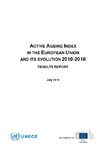Active ageing index in the European Union and its evolution 2010-2018: results report

Not available until 9999-99-99
View/
Use this link to cite
http://hdl.handle.net/2183/35571Collections
- Investigación (FSOC) [405]
Metadata
Show full item recordTitle
Active ageing index in the European Union and its evolution 2010-2018: results reportDate
2019Citation
“Active Ageing Index in the European Union and its evolution 2010-2018: Results report”, prepared by Yolanda González-Rábago and Antía Domínguez-Rodríguez of the University of the Basque Country (Bilbao), under contract with United Nations Economic Commission for Europe (Geneva), co-funded by the European Commission’s Directorate General for Employment, Social Affairs and Inclusion (Brussels).
Abstract
[Abstract] This report is structured in two sections with the analysis, on the one hand, of the situation of the 2018 Active Ageing Index (AAI), and, on the other, of the evolution of the index between 2010 and 2018. Thus, firstly, the results of the AAI in the whole of the 28 European Union countries are presented, describing the overall scores of the AAI and its dimensions in 2018. Secondly, the results of the AAI in time perspective are displayed, examining changes both in overall AAI and each of the dimensions from 2010 to 2018. Moreover, the results of 2018 and its evolution are shown for the whole population and disaggregated by sex, as well as the gender gap analysis in the overall score, the dimensions and its evolution.





